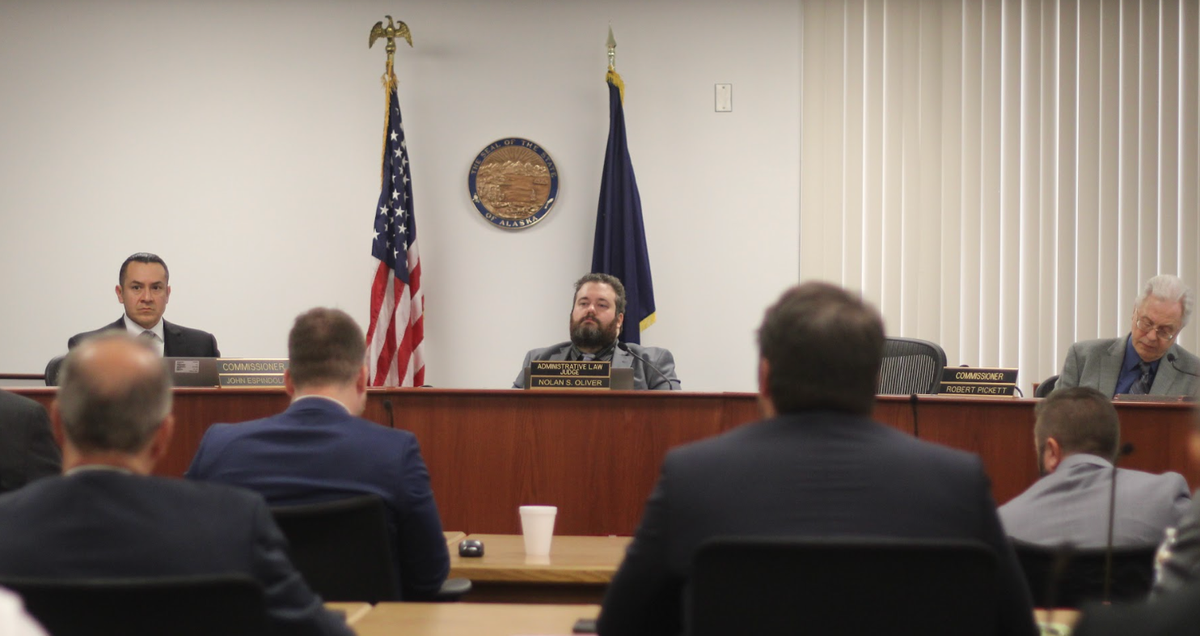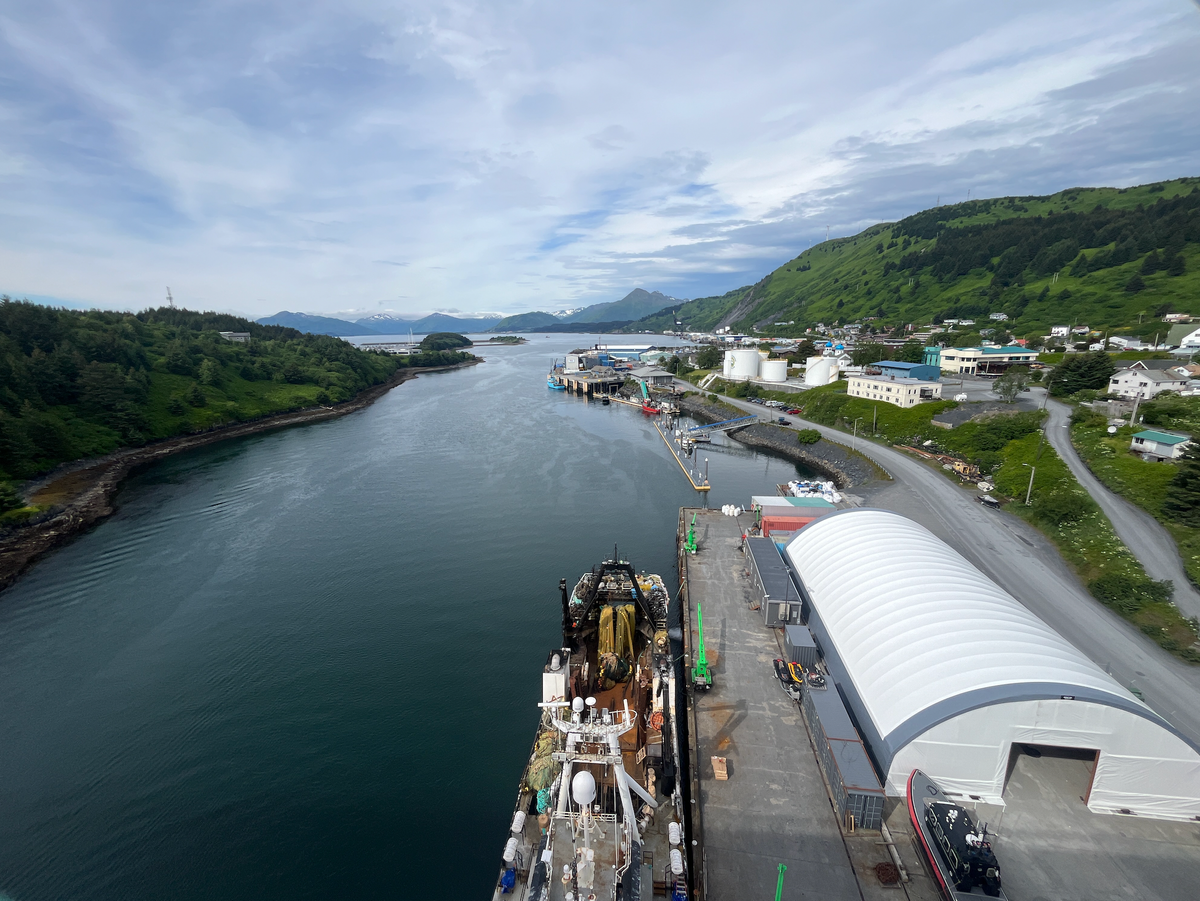Interesting Stuff: How Alaska regulators ignored a gas conservation scheme. And: What happened to those Kodiak king salmon?
The Regulatory Commission of Alaska rejected a proposal to increase electricity rates for heavier users. And: updates on the Kodiak king salmon bycatch incident and the future of Peter Pan Seafood.

Interesting Stuff is a periodic digest with news items and updates on stories that Northern Journal is following. This week's includes news on Anchorage's electric utility, updates on a Kodiak trawl bycatch incident and a struggling seafood company and, most importantly, additional black cod content.
A reminder: Northern Journal is a small business run by me, Nat Herz, and it depends on reader memberships, which pay for the vast majority of reporting expenses and also...my mortgage. If you find my work useful or informative, please consider a paid membership. If you already subscribe, thank you.
When Anchorage’s big electric utility asked regulators’ permission last year to raise its rates by 5.5%, renewable energy advocates responded with a counterproposal.
Could heavy residential users of power be charged even higher prices for each kilowatt of electricity, as a way to encourage conservation of Alaska’s dwindling supply of natural gas?
The Regulatory Commission of Alaska last week ruled on the broader rate increase requested by Chugach Electric Association.
The utility says it’s still studying the intricate, 89-page order to understand its effects.
But to the advocates who proposed the natural gas conservation scheme, there was one clear takeaway: The order made just one passing reference to their proposal, and, they say, it ignored a state law that requires the commission, when setting electricity rates, to “promote the conservation of resources” used to generate power.

“We don't see any findings about how that was considered. And we're in a natural gas crisis,” said Chris Rose, executive director of Renewable Energy Alaska Project, or REAP, which drafted the conservation proposal. He added: “We're still digesting the order. But our initial impression is that they haven't addressed an essential issue.”
REAP participated in the commission proceedings, known as a rate case, with free legal help from the environmental law firm Earthjustice. Rose and his attorneys were set to meet this week to discuss their options, which include asking the commission to reconsider its order or appealing the decision to the courts.
The commission, through spokesman Steven Jones, declined to comment, citing the potential for an appeal.
Chugach is analyzing the commission’s order “and will communicate with our members when we are clear on what it means for them,” said Julie Hasquet, a spokeswoman for the utility.
While neither Chugach nor the commission have specified how the details of the order could raise or lower the proposed 5.5% rate increase, the document does contain some clear conclusions.
The commission rejected a proposal by Chugach to raise its allowed profit margin, calculated using a financial benchmark called “times interest earned ratio,” or TIER. The utility wanted to raise its TIER — a ratio expressing how much the utility’s yearly earnings exceed its required debt payments — to 1.75 from 1.55, which, the commission said, would have raised rates by a total of $7.7 million.
In turning down that request, the commission said the existing TIER of 1.55 allows Chugach to “maintain its financial integrity” and lets the utility borrow money at “reasonable costs.”
The commission also rejected a request by Chugach to charge other utilities money to ship power across transmission lines it acquired when it bought Anchorage’s city-owned utility in 2020.

The city-owned utility did not charge those other utility customers for transmission. And the commission, in its order last week, said there was no evidence that Chugach bought the city assets for the benefit of those other utilities — concluding that they shouldn’t be charged under commission rate-setting guidelines that say costs should be paid by those who cause them.
What happened to those king salmon caught as bycatch?
Northern Journal last week published a story on how Kodiak-based pollock trawlers unintentionally caught 2,000 king salmon — forcing the closure of a major Gulf of Alaska fishery.
Afterward, a number of readers responded with similar questions: What happened to those salmon? Were they sold? Donated? Thrown back into the water?

The short answer, according to a federal management official: The salmon were “discarded.”
Some additional context: Salmon bycatch is “prohibited from entering commerce,” Josh Keaton, a top management official at the National Marine Fisheries Service, said in a brief call Friday.
“Nobody gets paid,” he said. “The fishermen can't take them home.”
The salmon caught by the trawlers were small, he said — four pounds, on average, compared to the 10 pounds that the smallest recreationally harvested salmon weigh.

When bycatch is of "marketable size" and suitable for food quality, Kodiak seafood companies will often process the fish and donate them to an Alaska nonprofit group, SeaShare, Keaton added. But in this case, they were probably too small, and also sat in containers for two days as independent fisheries observers took genetic samples of each one, he said.
Meanwhile, the fallout from the closure of the central Gulf of Alaska pollock fishery, in response to the salmon bycatch, continues. The Kodiak Daily Mirror reported Thursday that one of the city’s processing companies, OBI Seafoods, is laying off some 50 workers, with an executive telling the newspaper that remaining workers would see “significantly fewer hours,” as well.
The closure strands about $9 million of raw pollock in the Gulf of Alaska, which would have been processed into $50 million or more of headed and gutted fish, fillets, meal and oil, according to a preliminary analysis by Garrett Evridge, an Alaska fisheries economist.
The state and local government will also lose hundreds of thousands of dollars in fisheries tax revenue, according to Evridge’s analysis.
Editor's note: This item has been updated to remove a reference to the salmon being processed into fish meal. That detail, which came from a federal management official, could not be independently confirmed, and industry sources said that processing the salmon into meal would not be legal.
Peter Pan creditors, investors feud over sale of company assets to May
An array of businesses, fishing companies and investors are objecting to a pending proposal to sell the assets of a struggling Alaska seafood company to Rodger May — one of the original investors in the company before it entered a bankruptcy-like process called receivership.
The financial firm that’s overseeing Peter Pan Seafood's receivership proposed last week to sell the company’s three processing plants and an array of other assets to May, an entrepreneur and fish trader who narrowly outbid another processing company, Silver Bay Seafoods, in an auction.

A hearing on the proposal is set for Thursday in a Seattle courtroom, where a judge will consider the wide-ranging objections filed in court last week by opponents of the sale.
Those opponents include the investors who originally partnered with May to buy Peter Pan from a Japanese seafood conglomerate in 2020.
The investors — including affiliates of Los Angeles-based Renewable Resources Group and Anchorage-based McKinley Management — split with May in their filing, calling him an “insider whose inequitable conduct has both depressed the market for, and eroded the value of, Peter Pan’s assets.”
[Read some of filings in the receivership case from the investors, fishing companies and Silver Bay Seafoods.]
They say that Silver Bay is a better fit to buy the assets given opposition by the "Alaskan fishing community" to May's continued involvement in Peter Pan.
They also argue that May shouldn’t be allowed to apply $12 million in credit to his bid based on money he loaned Peter Pan. That's because another businessman, Los Angeles-based John Ketcham, also loaned $10 million to the company last year on the condition that he would be repaid before May, according to the investors' filing, which Ketcham also signed onto.
Ketcham has teamed up with Silver Bay and wants to use his loan as credit to buy one of Peter Pan’s three plants, in the remote Alaska Peninsula area called Port Moller.
May didn’t respond to a request for comment this week.
Hilcorp again eyes Interior for oil exploration
Oil and gas company Hilcorp appears to be moving toward new oil and gas exploration work in Alaska’s Interior, according to public documents released by state land managers.
Hilcorp on Sept. 19 applied to the Alaska Department of Natural Resources to install water level gauges in Birch Creek, not far from the Yukon River, “in support of oil and gas operations.”
Hilcorp has previously explored in the area in a partnership with Doyon, the Native-owned regional corporation for Interior Alaska.
The original agreement covered exploration of 1.6 million acres; just 3% of that area was selected by Hilcorp for further exploration this year, Doyon says on an informational web page.
"Plans for specific activities for the remainder of 2024 and 2025 are still in progress, but Hilcorp and Doyon will continue providing regular status updates to leaders in the region," the page says.
The area is relatively close to the trans-Alaska pipeline system, but it’s also near the Yukon Flats National Wildlife Refuge, which could complicate any plans for development.
Northern Journal is a black cod recipe blog now.
A quick reminder after last month’s public serv-fish announcement: Black cod is still being sold at bargain basement prices at Costco and elsewhere, and you should buy some.

Don’t take it from me — take it from the legions of readers who profited from Northern Journal’s advice, and already bought and cooked some of the supremely oily and delicious species.
“Sir,” gushed one enthusiast:
My wife and I lived in Anchorage for 35 years before retiring south to Washington state. Based on your story about AK Black Cod, we bought some fresh filets at our local Costco here on Washington’s Olympic Peninsula. We’ve been back to buy more since then, and what we haven’t eaten fresh has been cut up into portions and put in the freezer.
Yum! Sweet, fall-apart, moist, delicate buttery flakes, delicious! Excellent with fresh steamed local organic vegetables, or with fresh veggies roasted under the broiler.
We put the filets on parchment paper in a baking pan, skin side down. Drizzle with extra virgin olive oil and just a little roasted sesame oil. Sprinkle with fresh cracked pepper, a dash of garlic powder and cayenne pepper. Oven preheated at 435. Baked for 10 minutes. Removed from oven to separate filets from skin, flipped over and moved the skin to the side of the pan. Baked for seven more minutes and removed from the pan. Put the skin back in for six more minutes to crisp up on its own.
All turned out a feast for the eyes and palate. Brings back fond memories of our many ‘seafood fests’ upon coming home from Homer or Whittier fishing ‘expeditions.’
Can’t get enough of it.
Thank you so much for your recommendation.
Additional testimonials:
• The chowder was good — the pal I subjected it to was exclaiming about how much cream there was, which I wholly attribute to the richness from the cod and stock as it was just, like, a cup of 2% milk.
• A miso glaze broiled, as per a New York Times recipe. Took maybe 12 minutes, delicious and idiot proof. Served on a bed of rice with sautéed broccolini (used garlic from my garden). It was delicious. One of the best entrees I’ve ever made for myself, largely because the fish is so soft and buttery. I can’t wait to cook more of it.
• Hooray. Black cod is finally getting the credit it deserves. It is the Cadillac of fish. No, it is the Rolls Royce of fish. But it takes a good cook to do it justice. Most restaurants cook it too long, just as they mistreat most other kinds of fish. But we must be careful. The book Cod tells the story of the fish that fed a good part of the world until it was finished out. It would be tragic if black cod faced the same fate.
• I was successfully influenced by your piece. Shortly after reading, I found some Alaska black cod at the Washington Navy Yard/Capitol Hill Whole Foods on sale for $13.99 a pound, bought a little over a pound, and made it that night.
Preparation was simple: let it come to room temperature, lots of salt (don’t forget to salt the skin), two to three hours on the counter, pat dry. Get a pan screaming hot on the stove, preheat the oven to 325 degrees. Light olive or sesame oil and salt and pepper. Lay skin side down. Five to seven minutes on the stove, then hit it with lemon juice and into the oven for eight to 10 minutes.
Let it rest in foil for three to five minutes while you make green beans and asparagus in the pan.
Perfect every time. Good looking out. Not quite Nobu miso black cod, but so so good.
• Bought black cod after your article. Salted it and sauteed it, then made a pan sauce with onions, garlic, capers, butter, white wine and lemon. It was outstanding.
• Made this with black cod (and no clam juice), highly recommend.
And, finally, from Alaska’s highest profile fish-fluencer, former Gov. Bill Walker:







